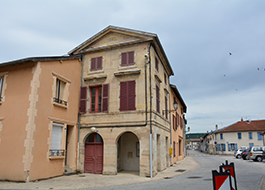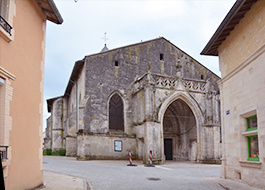Longeville-en-Barrois
Durée visite : 20 minutes
Moyen : Pédestre
Le village, inclus dans la Gaule belgique à l’époque gallo-romaine, développe la viticulture. Au Moyen Âge, Longeville appartient au comté de Bar, érigé ensuite en duché. En 1501, la première imprimerie lorraine fut créée ici par le prêtre Martin Mourot. Au XVIIe siècle, le village affranchi. Le développement économique est lié à la métallurgie et au travail du bois. En 1792, les soldats locaux se dotent d’un drapeau brodé avec la devise La liberté ou la mort. Il est présent à Valmy, Jemmapes et Fleurus. Le drapeau, sauvé des Prussiens en 1870, est caché dans la poutre d’une maison. Il est monument historique au titre d’objet. Il se trouve maintenant exposé dans la mairie. En 1851, la Compagnie du chemin de fer Paris-Strasbourg établit une gare. La SNCF l’a fermée, mais le bâtiment existe toujours, reconverti en logements. En 1905, Rudolph Diesel installe la première usine de moteurs à combustion interne. Elle se spécialisera par la suite dans les moteurs de bateaux. Une tannerie puis, en 1960, une scierie s’implanteront dans le bourg.
The village, included in Gaul Belgium in the Gallo-Roman era, develops viticulture. In the Middle Ages, Longeville belonged to the county of Bar, later erected into a duchy. In 1501, the first Lorraine printing press was created here by the priest Martin Mourot. In the 17th century, the village freed. Economic development is linked to metallurgy and woodworking. In 1792, local soldiers acquired a flag embroidered with the motto Liberty or Death. He is present in Valmy, Jemmapes and Fleurus. The flag, saved from the Prussians in 1870, is hidden in the beam of a house. It is a historical monument as an object. It is now on display in the town hall. In 1851, the Compagnie du chemin de fer Paris-Strasbourg established a station. The SNCF closed it, but the building still exists, converted into housing. In 1905, Rudolph Diesel set up the first factory for internal combustion engines. She will then specialize in boat engines. A tannery then, in 1960, a sawmill will be established in the village.
Das Dorf, das in der gallo-römischen Zeit zu Gallien in Belgien gehörte, entwickelt den Weinbau. Im Mittelalter gehörte Longeville zur Grafschaft Bar, die später zu einem Herzogtum errichtet wurde. 1501 wurde hier vom Priester Martin Mourot die erste lothringische Druckmaschine gegründet. Im 17. Jahrhundert wurde das Dorf befreit. Die wirtschaftliche Entwicklung ist mit Metallurgie und Holzbearbeitung verbunden. 1792 erwarben lokale Soldaten eine Flagge, die mit dem Motto Freiheit oder Tod bestickt war. Er ist in Valmy, Jemmapes und Fleurus präsent. Die Flagge, die 1870 vor den Preußen gerettet wurde, ist im Balken eines Hauses versteckt. Es ist ein historisches Denkmal als Objekt. Es ist jetzt im Rathaus ausgestellt. 1851 richtete die Compagnie du chemin de fer Paris-Straßburg eine Station ein. Die SNCF hat es geschlossen, aber das Gebäude existiert noch und wurde in Wohngebäude umgewandelt. 1905 gründete Rudolph Diesel das erste Werk für Verbrennungsmotoren. Sie wird sich dann auf Bootsmotoren spezialisieren. Eine Gerberei, 1960, wird im Dorf ein Sägewerk errichtet.

D’azur à une cane volante d’or.
Azure to a flying cane Or.
Azurblau zu einem fliegenden Stock Or.

Les habitants de Longeville-en-Barrois s’appellent les Longevillois et les Longevilloises.
The inhabitants of Longeville-en-Barrois are called Longevillois and Longevilloises.
Die Einwohner von Longeville-en-Barrois heißen Longevillois und Longevilloises.
Les points de visites
.
Le village est affranchi au XVIIe siècle. Il peut dés lors s’administrer lui-même. A ce titre, Longeville possède un maire, un lieutenant-général, un lieutenant particulier, un substitut, un greffier en chef et un greffier commis. Cette mairie s’installe dans ce bâtiment. A la fois cause et conséquence de ces libertés, un développement économique est alors enregistré.
The village was freed in the 17th century. It can therefore administer itself. As such, Longeville has a mayor, a lieutenant general, a private lieutenant, a substitute, a chief clerk and a clerk clerk. This town hall is installed in this building. Both cause and consequence of these freedoms, an economic development is then recorded.
Das Dorf wurde im 17. Jahrhundert befreit. Er kann sich also selbst verwalten. Als solches hat Longeville einen Bürgermeister, einen Generalleutnant, einen Privatleutnant, einen Stellvertreter, einen Hauptschreiber und einen Angestelltenschreiber. Dieses Rathaus ist in diesem Gebäude installiert. Ursache und Folge dieser Freiheiten wird dann eine wirtschaftliche Entwicklung erfasst.
.
.
L’édifice est construit au XVe et XVIe siècles. Il appartient au groupe des églises dites barroises de la Renaissance. Son porche est de style gothique flamboyant. Le choeur est couvert de voûtes appareillées. La statue de la Vierge à l’Enfant est la protectrice du village. L’intérieur est décoré d’une chaire sculptée, d’un orgue de tribune, inauguré en 1903, qui est de Charles Didier-Van Caster. Notons encore une statue du martyr de Sébastien . La croisée du transept est surmontée d’un clocher, orné d’une frise de roses et de têtes sculptées. S’adresser au secrétariat le la mairie. L, Ma, Me, J, V de 11h00 à 12h00 et de 14h00 à 17h00.
The building was built in the 15th and 16th centuries. It belongs to the group of so-called barroises churches of the Renaissance. Its porch is in the Flamboyant Gothic style. The choir is covered with paired vaults. The statue of the Virgin and Child is the protector of the village. The interior is decorated with a sculpted pulpit, a tribune organ, inaugurated in 1903, which is by Charles Didier-Van Caster. Let us note again a statue of the martyr of Sebastien. The crossing of the transept is surmounted by a bell tower, adorned with a frieze of roses and carved heads. Contact the secretariat on the town hall. M, Tu, We, D, V from 11:00 a.m. to 12:00 p.m. and from 2:00 p.m. to 5:00 p.m.
Das Gebäude wurde im 15. und 16. Jahrhundert erbaut. Es gehört zur Gruppe der sogenannten Barroises-Kirchen der Renaissance. Die Veranda ist im extravaganten gotischen Stil. Der Chor ist mit gepaarten Gewölben bedeckt. Die Statue der Jungfrau und des Kindes ist der Beschützer des Dorfes. Das Innere ist mit einer geformten Kanzel geschmückt, einer 1903 eingeweihten Tribünenorgel, die von Charles Didier-Van Caster stammt. Beachten wir noch einmal eine Statue des Märtyrers von Sebastien. Die Überquerung des Querschiffs wird von einem Glockenturm überragt, der mit einem Fries aus Rosen und geschnitzten Köpfen geschmückt ist. Kontaktieren Sie das Sekretariat im Rathaus. M, Tu, We, D, V von 11.00 bis 12.00 Uhr und von 14.00 bis 17.00 Uhr.







